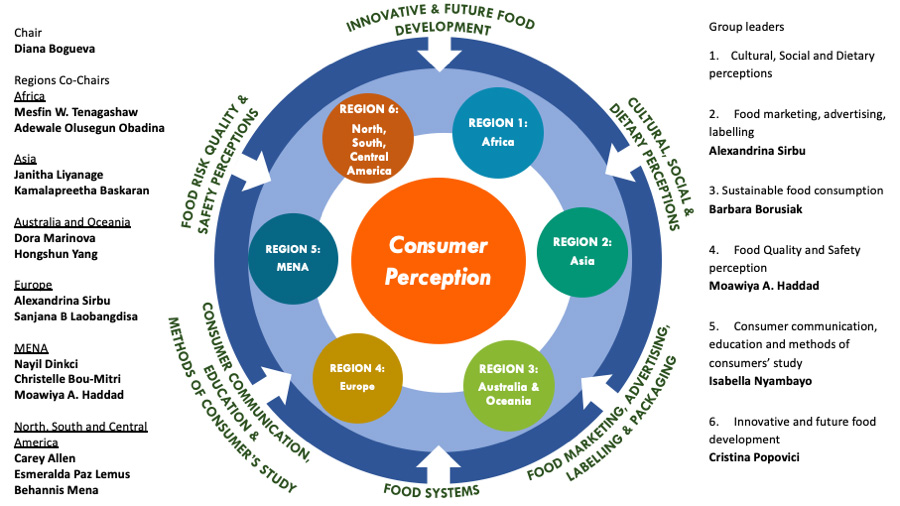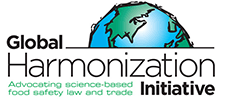
Consumer Perception Working Group
Consumer Perception Working Group
Chair

Dr. Diana Bogueva
Australia
Mission
The Consumer Perception Working Group's mission is to promote the investigation of consumer behaviour regarding food safety, food security and food legislation and practices harmonization and contribute to a sustainable consumer-driven food supply chain.
Objectives
The Consumer Perception Working Group brings together individuals having the relevant knowledge and skills to elaborate, consolidate, and collaborate on new or existing initiatives, driving collective actions and build on the GHI primary objectives of food safety, food security and harmonization. The group will focus on various areas of consumer perceptions related issues, including:
- Cultural, social and dietary perceptions
- Food marketing, advertising, and labelling
- Sustainable food consumption and systematic losses and waste in a food chain
- Food risk, quality and safety perceptions
- Consumer communication, education and methods used for consumer studies
- Innovation and future food developments
The working group will aim to achieve the following:
- Investigate the cultural and social dimensions across regions and consumer perceptions of food and food safety, food security and harmonization.
- Formulate ideas about consumer perception based on consensus-building discussions about the role of new food technologies, acceptance of novel food products and technologies, levels of food processing (high, minimally and non-processed) and concerns about the risks to human health and the environment.
- Investigate the needs and preferences of the consumers with respect to food safety, food quality and appropriateness of particular foods, and their level of awareness of the contemporary issues related to food safety and quality.
- Find mechanisms to provide knowledge and suitable information regarding the use and understanding of labelling, special symbols and various claims based on a better knowledge of consumer law so that global label harmonization may proceed forward.
- Take actions to encourage harmonization of labelling globally or regionally by developing new information.
- Provide consumer education using dialogue with various important stakeholders that will help create the necessary communication to respond better to consumer needs and concerns.
- Generate science-based information to increase consumers’ knowledge about food quality and safety to help them develop their purchase criteria.
- Identify strategies to increase consumer trust of the food industry and of new technologies.
- Represent consumer interests consistent with the goals of GHI related to ensuring safe food for everybody on the globe and harmonisation of practices.
- Identify Impacts of changes on consumers as they are the critical stakeholder in the food system.
- Identify drivers and barriers of consumer behaviors as they relate to various consumer subgroups.
- Bridge the gap and strengthen consumer ownership of the drive for good nutrition and food safety at the local, national and regional levels.
- Understand how different age groups are influenced by product trends and adapt to new trends such as vegetarianism, veganism and flexitarianism.
- Create a digital forum to share credible food safety-related consumer information on food safety and risk-assessment.
- Investigate beliefs, impression, awareness, consciousness, value alignment, communication and trust signal formation processes that consumers used to deal with scientifically-based facts, innovations and technologies.
- Strengthen the local, national and regional infrastructure to use GHI to deliver information that will improve consumer awareness and rights.
- Assist in developing and attaining long term consumer satisfaction with their food supply and its food safety and quality through coordinated policies aimed at the consumer and other stakeholders.
- To create inclusiveness in the food value chain that will bridge the gap and sustainably strengthen consumer ownership of the drive for good nutrition and food safety at the local, national and regional levels.
The Working group will have six regions’ co-chairs and six group leaders, each with defined responsibility as indicated in the figure.

Meetings
Dates, times and locations to be announced.
Interested in joining this Working Group?
If you have suggestions or are interested in joining our efforts and contributing constructively to our Working Group, please contact the Working Group Chair or the Working Group Coordinator via email. Your request will be reviewed to ensure that your expertise is matched to this WG area of interest.
Only registered members of GHI are eligible to join its Working Groups. If you are not already a GHI member, click here to join our global community of scientists and experts. There is no fee to join GHI.
